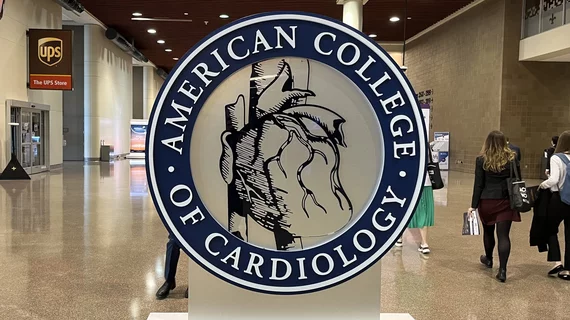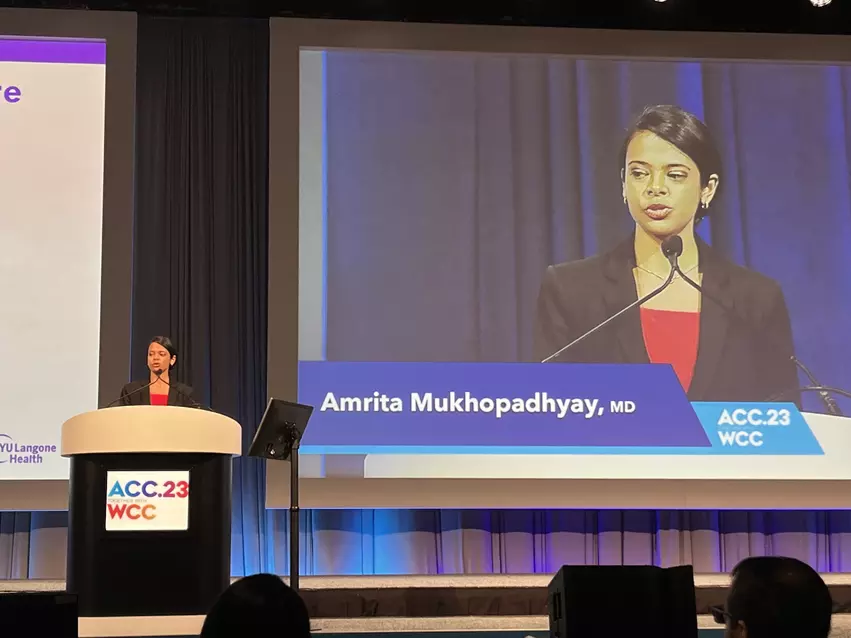Day 2 at ACC.23 features late-breaking studies on TEER, TAVR, EHR alerts and much more
The second day of the American College of Cardiology’s annual meeting, ACC.23 Together with the World Congress of Cardiology, opened with two rounds of late-breaking clinical trials that covered everything from structural heart disease to electronic health record (EHR) alerts.
Catch up on the busy day below:
Five-year COAPT results
Perhaps the most anticipated late-breaker of the day was presented by Gregg Stone, MD, a professor with Mount Sinai in New York City. Stone was there to share the final five-year outcomes from the COAPT trial, a study focused on transcatheter edge-to-edge repair (TEER) with Abbott's MitraClip device. The COAPT trial included 614 patients with an average age of 72 years old. Thirty-six percent of patients were women. All patients presented with left ventricular failure, severe mitral regurgitation (MR) and heart failure symptoms even though they were already taking medications.
Overall, the five-year outcomes confirmed that TEER, previously known as transcatheter mitral valve repair, with the MitraClip device was associated with a reduction in heart failure hospitalizations and improved survival among patients presenting with severe secondary MR. The device was also linked to consistent MR reductions.
The MitraClip device was approved by the U.S. Food and Drug Administration for this purpose in 2019. According to a prepared statement from Abbott, it has already been used to treat more than 150,000 patients around the world.
“With nearly two decades of clinical experience in transcatheter mitral repair, Abbott's MitraClip has paved the way for innovation in helping people with MR, providing an alternative to surgery for patients who often need treatment to survive,” Michael Dale, senior vice president of Abbott's structural heart business, said in the statement. “These results reinforce that MitraClip plays a critical role in not only improving the symptoms of people with this serious heart condition, but also getting them back to living their fullest lives.”
The full five-year results have been published in the New England Journal of Medicine; they can be read here.
An updated look at TAVR among low-risk patients
Another anticipated late-breaker was delivered by John K. Forrest, MD, director of interventional cardiology and structural heart disease at Yale University School of Medicine.
Forrest shared three-year results from the Evolut Low Risk Trial, an ongoing study of the safety and effectiveness of Medtronic’s supra-annular, self-expanding transcatheter aortic valve replacement (TAVR) systems in low-risk aortic stenosis patients. Overall, the benefits of TAVR in this patient population have remained consistent after three years.
After three years, patients treated with the Medtronic TAVR valves faced a lower risk of all-cause mortality or disabling stroke than patients treated with surgical aortic valve replacement (SAVR). Prosthesis-patient mismatch was also less likely among TAVR patients than SAVR patients.
One key detail about the Evolut Low Risk Trial is that it includes data from seven different countries; its 1,468 patients come from the United States, Australia, Canada, France, Japan and the Netherlands.
“These data add to the robust body of evidence demonstrating that the Evolut platform offers excellent valve performance and remains hemodynamically stable for years to come in younger, healthier patients,” Nina Goodheart, senior vice president and president of Medtronic’s structural heart and aortic business, said in a prepared statement about the data.
The full results have been published in the Journal of the American College of Cardiology; read them here.
Comparing mitral valve repair strategies
Enoch Akowuah, MD, a cardiothoracic surgeon with Newcastle University, shared his team’s analysis comparing minimally invasive and conventional surgical techniques for repairing the mitral valve. The group examined data from 330 patients randomized to undergo either a mini-thoracotomy or a conventional sternotomy. The mean patient age was 67 years old, 30% of patients were women and 92% presented with severe MR.
Overall, the group found that a minimally invasive mini-thoracotomy, which can be completed with a small incision instead of opening the patient’s chest completely, was a safe and effective treatment option. In addition, it was linked to a quicker recovery for the patient and a shorter length of stay than conventional sternotomy.
“Because these patients are often younger and still working, the benefits of a shorter hospital stay and increased physical activity at six weeks may be important factors for them,” Akowuah said in an ACC statement highlighting the data. “We hope that the results of this trial will give confidence to both clinicians and patients and drive uptake of the mini approach.”
Immediate complete revascularization in patients with multi-vessel disease
Robert Diletti, MD, PhD, an interventional cardiologist with Erasmus University Rotterdam, presented late-breaking data on the treatment of multi-vessel disease in heart attack patients in the BIOVASC: Complete Revascularization Strategies in Patients Presenting With Acute Coronary Syndromes and Multivessel Coronary Disease study. His team examined data from 1,525 European patients with a median age of 65 years old. Twenty-two percent of patients were women. The group was randomized to undergo immediate complete revascularization or staged complete revascularization.
The study’s primary endpoint—a combination of all-cause death, repeat myocardial infarction, unplanned stenting procedures or cerebrovascular events after one year—was seen in 7.6% of patients in the complete revascularization group and 9.4% of patients in the staged complete revascularization group. This led Diletti et al. to conclude that complete revascularization was not inferior to staged complete revascularization. Also, patients in the staged group were much more likely to experience a repeat myocardial infarction than patients in the complete revascularization group (9.4% vs. 4.5%).
The benefits of intravascular imaging-guided PCI
Another late-breaker was the RENOVATE-COMPLEX-PCI study presented by Joo-Yong Hahn, MD, PhD, director of interventional cardiology at Samsung Medical Center in Korea. Hahn et al. investigated the benefits of intravascular imaging-guided percutaneous coronary intervention (PCI) compared to angiography-guided PCI. Patients in the intravascular imaging arm were evaluated using intravascular ultrasound (IVUS) or optical coherence tomography.
Overall, the group found, the use of intravascular imaging was linked to key improvements in cardiovascular outcomes. The study’s primary endpoint, a combination of heart disease-related death, target vessel-related myocardial infarction or clinically-driven target vessel revascularization, was seen in 7.7% of patients treated with intravascular imaging-guided PCI and 12.3% of patients treated with angiography-guided PCI.
“The results of our trial may lead to an increase in the use of intravascular imaging—and, in turn, an improvement in clinical outcomes—among patients with complex coronary blockages who are undergoing stenting,” Hahn said in an ACC statement.
(The ACC recently urged all interventional cardiologists to use intravascular imaging during PCI procedures. Read more here.)
Improving MRA utilization through the EHR
The first of a series of late-breaking clinical trials focused on using electronic alerts and “nudges” was presented by Amrita Mukhopadhyay, MD, a cardiologist with NYU Grossman School of Medicine. In the BETTER CARE-HF study Mukhopadhyay explored data from 180 cardiologists within a large health system to see how different notification types impacted the prescription of mineralocorticoid receptor antagonists (MRAs), a guideline-recommended class of heart failure medications.
The team tracked the effectiveness of EHR-embedded alerts and monthly emails sent to a cardiologist’s inbox. EHR-embedded alerts were the most effective option for reaching cardiologists, more than doubling the rate of MR prescriptions among cardiologists, though the monthly emails were also linked to an improvement compared to usual care.
Mukhopadhyay noted that the group specifically designed these EHR-embedded alerts to not be intrusive, because they wanted to avoid “alert fatigue” whenever possible. Also, for the same reason, alerts were only sent to a cardiologist when it was believed the patient would truly benefit from being treated with an MRA.
Can CDS reminders get more patients on high-intensity statins?
Salim Virani, MD, PhD, a cardiologist with the Michael E. DeBakey VA Medical Center and Baylor College of Medicine, both in Houston, presented another fascinating late-breaker focused on improving care through electronic alerts in the PCDS Statin study.
Virani’s team used artificial intelligence algorithms and interviews with patients and clinicians to develop clinical decision support reminders related to the use of high-intensity statins. The group then implemented those reminders in 14 clinics, selecting another 13 clinics to carry with usual care. Overall, the study included a total of more than 36,000 patients.
The digital reminders appeared to be quite effective; the number of patients prescribed high-intensity statins increased by 3.8% across the entire intervention arm and 10.1% among patients who were specifically included in a reminder.
A significant takeaway from this analysis was that 31.6% of participating clinicians chose to opt out of the reminders. Considering that the reminders were already designed to not overwhelm the cardiologists, this shows that more work may still be needed to ensure physicians embrace workflow interventions that can improve patient outcomes. Additional research is already planned to explore why so many clinicians chose to opt out.
The team’s findings were published in full in Circulation; read them here.
Eliminating medication copays fails to boost outcomes
Braden J. Manns, MD, MSc, a professor of health economics at the University of Calgary, presented findings from a randomized clinical trial on the impact of eliminating copayment costs.
Manns et al. followed more than 4,700 Canadian patients for a median of three years. Overall, eliminating all copayment costs on a variety of cardiovascular medications was not associated with any significant difference in cardiovascular outcomes. The intervention saved patients approximately $26 per month, but this did not translate to any improved outcomes.
The analysis was performed in Canada, where healthcare costs are not nearly as high as in the United States. Would a similar study on U.S. patients have a different outcome? For now, that much remains unclear.
The team’s findings were published in full in Circulation; read them here.



